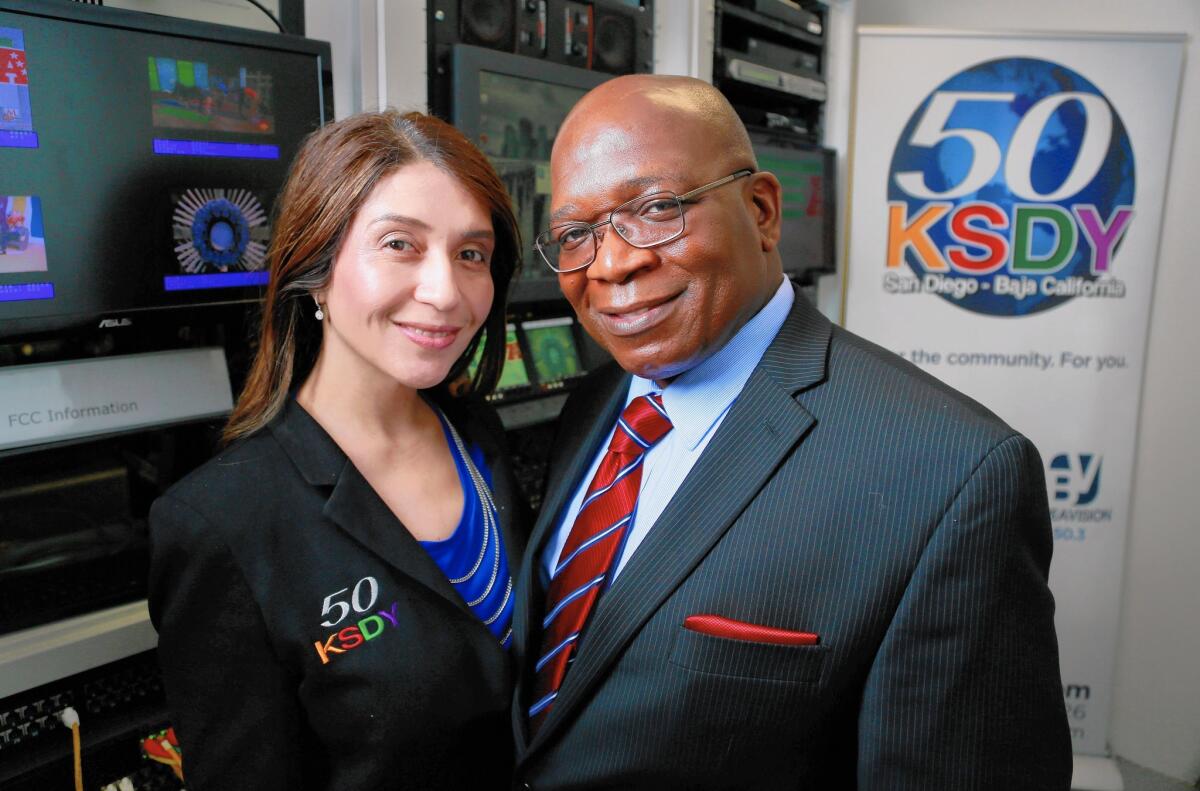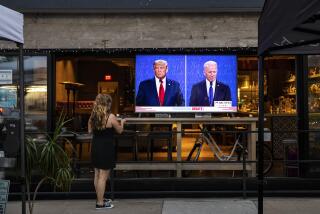Many small TV stations may soon be forced off the air

Maxwell C. Agha and his wife, Michelle Diaz Agha, have pumped $15 million into their small San Diego TV station over the last two decades so they could broadcast Spanish-language news, Catholic shows and local programming.
But KSDY-TV Channel 50 and many other small, low-power TV stations, which often broadcast foreign-language and religious programming, soon could be silenced — knocked off the air involuntarily by the federal government with no compensation to their owners or alternatives for their often low-income viewers.
The stations are the potential collateral damage of an ambitious attempt, set to begin next month, to transform the public airwaves for the mobile needs of the 21st century.
See more of our top stories on Facebook >>
The Federal Communications Commission plans to use a complex auction to shift a huge swath of public airwaves from carrying TV signals to delivering wireless services to smartphones and other data-hungry mobile devices.
Because of that effort, the Aghas could face the prospect of spending millions of dollars more to keep their station on the air by moving to another channel — if one is even available after broadcasters are squeezed into a smaller chunk of the radio-wave spectrum.
If there is no free channel available, KSDY would go dark.
“They awarded these licenses and asked people to invest and now they say they can just take this and auction it and keep the money,” said Maxwell Agha, chief executive of International Communications Network Inc., which owns the station. “It’s a totally unfair process.”
The two-part auction, which begins March 29, aims to attract some of the nation’s 1,782 full-power broadcasters and 405 specially licensed Class-A low-power stations to give up their rights to those airwaves in exchange for a cut of the proceeds paid by wireless providers for licenses to use them.
The auction could produce as much as $40 billion in new licensing fees from AT&T Inc., Verizon Communications Inc. and other wireless providers. Proceeds of even half that could lead to a jackpot of hundreds of millions of dollars to some TV station owners who decide to give up their airwaves.
But the auction could be a disaster for many of the smallest players in the broadcast world and their viewers: the 1,822 standard low-power TV stations.
“It’s catastrophic,” said Ravi Kapur, who owns a Chicago low-power station and founded a network that airs South Asian programming on low-power stations in Los Angeles and Houston. “These stations will go off the air and there will be a whole lot of calls to the FCC and members of Congress and it will be too late.”
The FCC created low-power TV licenses in 1982 “to provide opportunities for locally oriented television service.” The stations are limited in their signal power, allowing them to broadcast on unused patches of the airwaves as long as they don’t cause interference with full-power stations.
Because they are easier to obtain and less costly to run, low-power TV stations have a much more diverse ownership.
About 15% of the stations were owned by women, 10% by Latinos and 1.3% by blacks, as of 2013, the most recent FCC data available. That compares with 6.3% of full-power stations owned by women, 3% by Latinos and 0.6% by blacks.
“The FCC is obliterating the most successful program they’ve ever implemented to diversify media ownership,” said Kapur, who runs Diya TV, which is billed as “America’s first 24/7 South Asian broadcast television network.”
The auction rules highlight that low-power stations are second-class citizens in the broadcast world.
Unlike full-power station owners, low-power broadcasters won’t get any of the auction proceeds. Low-power TV station owners also are ineligible for the $1.75 billion in federal money set aside to help broadcasters who want to stay on the air pay for the new equipment needed to move to another channel.
In addition, the auction could cause thousands of other viewers to lose not just low-power signals but all over-the-air TV.
Residents of rural areas, valleys and other locations that are difficult for broadcasts to reach are at risk because hundreds of signal-boosting transmitters, often owned by local governments, also could be pushed off the condensed broadcast airwaves.
“There are places where that’s going to be devastating,” said Michael Couzens, a communications attorney who does work for San Bernardino County.
The county has five special taxing districts that own and operate TV towers with translator stations that extend Los Angeles broadcast signals. “Many of the places we serve do not have cable because they’re too sparsely populated to lay the cable to,” Couzens said.
FCC Chairman Tom Wheeler has called low-power TV “an important voice in the community,” and the agency has taken steps to help stations, including translators, stay on the air.
Those measures include permitting stations to share channels, using special software to squeeze as many channels into the remaining spectrum as possible and allowing stations to stay on auctioned airwaves until the buyer is within 120 days of using them.
But physics, math and federal law still pose major obstacles.
There’s a finite amount of public spectrum, so condensing it means channels for fewer stations, particularly in urban areas such as Southern California. Adding to the complications are the FCC’s plans to set aside some additional broadcast spectrum for use by Wi-Fi-enabled devices.
Low-power broadcasters are not allowed to cause interference with full-power TV signals, further limiting their options.
The auction will cost the low-power TV industry about $1 billion in additional spending and lost investment, said Mike Gravino, director of the LPTV Spectrum Rights Coalition, which advocates for the industry.
Some low-power broadcasters have gone to court to challenge the auction rules. And the potential problems of low-power TV have raised concerns in Congress.
“The owners of these stations do provide a service,” said Rep. Joe Barton (R-Texas), who asked the Government Accountability Office to study the auction’s effect on them. “They are licensed. They have invested their own money.”
Barton said Congress might need to pass legislation to help low-power stations if the auction produces major problems.
At KSDY in San Diego, the Aghas are worried about the sliver of the airwaves they use to air programs such as “It’s Your San Diego” and “The Go Navy Show” on Channel 50, as well as Latino and religious shows on three digital sub-channels.
“The government wants to take it and raise a lot of money and we’re not going to get a dime of it,” Maxwell Agha said.
He and his wife are particularly frustrated because their station already has spent millions of dollars to move its channel, which is further complicated because it has to avoid interference with U.S. and Mexican broadcasters.
KSDY started out on Channel 61, but the FCC forced all broadcasters to move below Channel 52 as part of the transition to digital TV that began in the late 1990s. The Aghas said they conducted expensive engineering studies and were awaiting approval to move to Channel 38, but the Mexican government grabbed that channel.
They applied to become a Class-A station, which would have given them a greater chance of finding a new channel and federal compensation to make the move. But the FCC denied the application in 2014.
“We are a minority-owned business and community-based,” said Michelle Diaz Agha, chief operating officer of International Communications Network. “All we want at the end of the day is to be the voice that we’ve been working for and investing in.”
ALSO
Beverly Center joins a rush for mall makeovers
Restaurants are booming despite financial market turmoil
SeaWorld San Diego plans to add a major aquarium-based attraction







